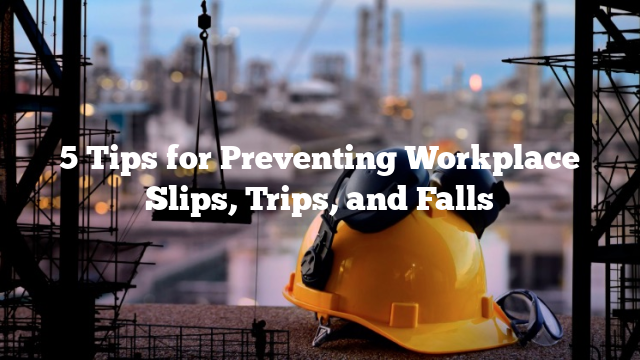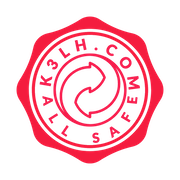Workplace Slips Trips and Falls Prevention
Every year, millions of people suffer from injuries caused by slips, trips, and falls in the workplace. These accidents can happen in any industry, but they are particularly common in construction, manufacturing, and healthcare. Not only can these accidents cause physical harm, but they can also result in lost productivity, increased insurance costs, and potential legal liabilities for employers. In this blog post, we will explore what workplace slips, trips, and falls are, why they happen, and how to prevent them.
What are Workplace Slips, Trips, and Falls?
Slips, trips, and falls are the most common workplace accidents. According to the Occupational Safety and Health Administration (OSHA), slips, trips, and falls account for 15% of all accidental deaths, second only to motor vehicle accidents. A slip occurs when there is a loss of traction between the foot and the walking or working surface. A trip occurs when a foot strikes an object, causing a loss of balance. A fall occurs when a person drops to a lower level, such as from a ladder or a roof.
Why Do Workplace Slips, Trips, and Falls Happen?
There are many reasons why slips, trips, and falls happen in the workplace. Some of the most common causes include:
– Wet or slippery surfaces
– Uneven or damaged flooring
– Poor lighting
– Cluttered or obstructed walkways
– Loose or missing handrails
– Unguarded edges or openings
– Inadequate training or supervision
Facts About Workplace Slips, Trips, and Falls
Here are some facts about workplace slips, trips, and falls that you may not know:
– Slips, trips, and falls cost employers $11 billion annually in workers’ compensation claims.
– Falls from heights are the leading cause of death in the construction industry.
– Women are more likely than men to suffer injuries from falls in the workplace.
– Employees aged 55 and older are more likely to suffer serious injuries from falls than younger workers.
– Most slips, trips, and falls occur on the same level, rather than from a height.
A Listicle of Workplace Slips, Trips, and Falls Prevention
Preventing slips, trips, and falls in the workplace requires a comprehensive approach, including regular maintenance, employee training, and hazard assessments. Here are seven tips for preventing workplace slips, trips, and falls:
1. Keep floors clean and dry to prevent slips. Use anti-slip mats and footwear if necessary.
2. Repair or replace damaged flooring promptly to prevent trips.
3. Ensure adequate lighting in all areas of the workplace.
4. Keep walkways and stairways clear of clutter and obstacles.
5. Install handrails and guardrails where necessary.
6. Provide proper training and supervision for employees.
7. Conduct regular hazard assessments to identify potential risks and take corrective action.
Tutorial of Workplace Slips, Trips, and Falls Prevention
Here is a step-by-step tutorial to prevent workplace slips, trips, and falls:
Step 1: Conduct a hazard assessment of your workplace to identify potential risks.
Step 2: Address any hazards that are identified, such as repairing damaged flooring or installing handrails.
Step 3: Ensure that your employees are properly trained on how to identify and avoid slip, trip, and fall hazards.
Step 4: Develop and implement a cleaning and maintenance schedule to keep floors and walkways clean and dry.
Step 5: Provide anti-slip mats and footwear as necessary to prevent slips.
Step 6: Ensure that there is adequate lighting in all areas of the workplace.
Step 7: Conduct regular safety audits to ensure that your slip, trip, and fall prevention program is effective.
Tips of Workplace Slips, Trips, and Falls Prevention
Here are five additional tips for preventing workplace slips, trips, and falls:
1. Encourage employees to report hazards and near-misses.
2. Address hazards promptly to prevent injuries.
3. Provide proper footwear for the job.
4. Use warning signs to alert employees of potential hazards.
5. Conduct regular safety meetings to reinforce safe work practices.
Question and Answer of Workplace Slips, Trips, and Falls Prevention
Q1: What are the most common causes of slips, trips, and falls in the workplace?
A1: The most common causes of slips, trips, and falls in the workplace include wet or slippery surfaces, uneven or damaged flooring, poor lighting, cluttered or obstructed walkways, and loose or missing handrails.
Q2: How can employers prevent slips, trips, and falls in the workplace?
A2: Employers can prevent slips, trips, and falls in the workplace by conducting regular hazard assessments, providing proper training and supervision, addressing hazards promptly, and providing anti-slip mats and footwear.
Q3: Who is most at risk for workplace slips, trips, and falls?
A3: Women are more likely than men to suffer injuries from falls in the workplace, and employees aged 55 and older are more likely to suffer serious injuries from falls than younger workers.
Q4: How much do slips, trips, and falls cost employers annually?
A4: Slips, trips, and falls cost employers $11 billion annually in workers’ compensation claims.
Conclusion of Workplace Slips, Trips, and Falls Prevention
Preventing workplace slips, trips, and falls is essential for ensuring the safety and wellbeing of employees and reducing costs for employers. By following the tips and strategies outlined in this blog post, you can create a safer workplace and prevent slips, trips, and falls from occurring. Remember to conduct regular hazard assessments, provide proper training and supervision, and address hazards promptly to keep your workplace safe and productive.
Recommendations:
- Safety Insurance Group Engages in the management and provision of insurance services. Provides personal lines property and casualty insurance focused exclusively on the massachusetts market. Insurance Safety Insurance Safety insurance group inc. Safety…
- Safety Vest And Hard Hats Safety gear pro has a variety of different high quality safety gear equipment such as safety glasses ppe hard hats safety shoes safety vest harness. Ansi rated safety vests with…
- Safety Signs Construction Construction site signs at guaranteed low prices. For bulk order quotes or for more information on which construction sign is the most suitable for your needs please call our customer…
- Health And Safety Law Poster Free Pdf Download 2 let you know who is responsible for making this happen. The reason that these posters are free is that this still accounts for a vast majority of workplace injuries.…
- Picture Of Safety Equipment If you're looking for picture of safety equipment pictures information connected with to the picture of safety equipment topic, you have visit the right blog. Our website frequently gives you…
- Safety Inspection Report Example Page 1 of 3. Formal inspections can take different forms and you and your representatives will need to agree the best methods for your workplace. Safety Report Templates 16 Pdf…
- 10 Tips for Preventing Slips, Trips and Falls in the… Workplace Slips Trips and Falls Prevention: Essential Tips and Facts Accidents in the workplace can happen anytime, anywhere. One of the most common types of these accidents is slips, trips,…
- Construction Site Safety Inspection Checklist The standards referred to are south carolinas occupational safety and health standards for the construction industry as adopted from 29 cfr code of federal regulations part. Some construction companies will…
- Health And Safety Inspection Procedure Further information of the inspection procedure is available. First aid in the workplace. Ohs Worksite Inspections February Health Safety Systems The Goal Health and safety committees can help plan conduct…
- Health And Safety Inspection Form Safety inspections are essential to ensuring and effective safety program. More about download the free osh answers app. Workplace Health And Safety Inspection Forms Survey Templates And Alternatively they may…
- The Top 10 Safety Hazard In Kitchen and How To… Each group is allocated one of the food safety hazard in kitchen and must come up with a short drama that shows. We use our kitchens every day to prepare…
- Health And Safety Committee Logo Dumpster health and safety signs hard hat truck driver protect your health health safety environment health and safety committee vehicle. Health in each workplace. Call For Joint Health And Safety…
- Free Health And Safety Images If you're searching for free health and safety images images information linked to the free health and safety images keyword, you have pay a visit to the ideal site. Our…
- Hazard And Risk Images If you're searching for hazard and risk images images information linked to the hazard and risk images keyword, you have come to the ideal site. Our site frequently gives you…
- Health And Safety Poster Uk Health and safety posters. Free health and safety posters. Health And Safety Law What You Need To Know Hse Law Poster A2 The health and safety executive has produced a…
- Sample Of Safety Inspection Checklist There are several ways to perform safety inspections of a workplace task or job. Safety inspection checklist buildingdepartments. 18 Inspection Checklist Examples Samples Pdf Word Pages The best checklist for…
- Discover Job Hazard Analysis Examples to Improve… Job Hazard Analysis Examples. Every workplace has its own set of safety standards and procedures. But it can be difficult to know which safety protocols are most effective, and which…
- 7 Tips for Preventing Slips, Trips, and Falls in the… Introduction: Slips, trips, and falls are some of the most common workplace accidents, causing not only physical harm but also financial losses for businesses. According to the Occupational Safety and…
- Hand Safety Pictures If you're searching for hand safety pictures images information related to the hand safety pictures topic, you have come to the ideal site. Our website frequently gives you hints for…
- 10 Effective Measures to Prevent Workplace Slips,… Workplace Slips Trips and Falls Prevention: Keeping Your Workplace Safe Workplace safety is an essential aspect of any business operation. Many accidents can occur in the workplace, but slips, trips,…
- The Importance of Workplace Slips, Trips, and Falls… Workplace Slips, Trips, and Falls Prevention: Keeping Your Employees Safe As an employer, one of your top priorities should be ensuring the safety of your employees. Unfortunately, slips, trips, and…
- Safety Inspection Report Format Safety inspection report forms are forms that are used by professionals to report on the kind of safety violations if there are any of certain establishments by conducting a thorough…
- Health And Safety Funny Images If you're searching for health and safety funny images images information related to the health and safety funny images interest, you have pay a visit to the right site. Our…
- Safety Insurance Pay My Bill Safety insurance designed online bill pay to provide you with a safe and secure means of paying your insurance premium. I contacted my insurance and they are also having trouble…
- Safety Hazard Meaning 2013 defines hazard a subjective concept that refers to the possibility of the circumstances under which the matter field information energy or both of them may influence the complex system…
- 5 Essential Tips for Preventing Slips, Trips and… Introduction: Did you know that slips, trips, and falls are the leading cause of workplace accidents? In fact, according to the National Safety Council, over 9 million slip, trip, and…
- Safety Insurance Group Inc It offers property and casualty insurance products which include commercial vehicles and fleets. Saft including business summary industrysector information number of employees business summary corporate governance key executives. Safety Insurance…
- Environment Health Safety Logo Downloading this artwork you agree to the following. Download health and safety stock photos. Hse Health Safety And Environment Intecsa Industrial Affordable and search from millions of royalty free images…
- Safety Precautions Meaning Safety precautions meaning are measures taken to prevent or reduce the risk of accidents, injuries, illnesses, or damages in various settings and situations. Safety precautions are essential for protecting workers,…
- Safety Insurance Login Safety insurance is a premier provider of auto home and business owners insurance in massachusetts new hampshire and maine. Safety insurance is rated a excellent by am. Safety Insurance Login…
Advertisement
Scroll to Continue With Content




